Site-Specific Net Suspended Sediment Flux and Turbidity–TSM Coupling in a UNESCO Tidal Flat on the Western Coast of Korea: High-Resolution Vertical Observations
Abstract
1. Introduction
2. Materials and Methods
2.1. Study Area
2.2. Investigation on Research Vessel Eun-A
2.3. Instrumentation and TSM Analysis
3. Results
3.1. Tidal Level and Light Intensity Time Series
3.2. Characteristics of Turbidity, TSM, and Other Parameters
3.3. Time Series Characteristics of Turbidity (NTU) and TSM Correlation
3.4. Net Suspended Sediment Flux Calculation
3.5. Measurement of Suspended Sediment Inflow and Outflow
3.6. Net Suspended Sediment Transport and Residual Flow Characteristics
4. Discussion
4.1. Limitations and Implications for Bay-Wide Sediment Budget
4.2. Interpretation of Net Sediment Transport Patterns
4.3. Turbidity–TSM Relationship and Calibration Potential
4.4. Tidal Modulation of Water Column Properties
4.5. Implications for Tidal Flat Morphodynamics
4.6. Comparison with Global Estuarine Studies
5. Conclusions
- (1)
- (2)
- (3)
- (4)
- Although future deployments of high-performance, spatially resolved instruments may reduce these issues, uncertainties remain due to sensor depth placement and the inherent limitations of optical backscatter sensors (OBSs) in heterogeneous sediment regimes, which can affect calibration accuracy (e.g., ADCP-related constraints) [44,62].
Supplementary Materials
Author Contributions
Funding
Data Availability Statement
Acknowledgments
Conflicts of Interest
Abbreviations
| ADCP | Acoustic Doppler Current Profiler (General water current velocities) |
| CDOM | Colored Dissolved Organic Matter (General mg·m−3) |
| CTD | Conductivity (µS·cm−1), Temperature (°C), Depth (m) Profiler |
| DO | Dissolved Oxygen (mg·L−1) |
| ETM | Estuarine Turbidity Maxima |
| FTU | Formazin Turbidity Unit (dimensionless) |
| IHS | Inclined Heterolithic Stratification |
| NTU | Nephelometric Turbidity Unit (dimensionless) |
| OBS | Optical Backscatter Sensors |
| POC | Particulate Organic Carbon |
| RCM | Recording Current Meter |
| SPM | Suspended Particulate Matter (mg·L−1) |
| SSC | Suspended Sediment Concentration |
| TSM | Total Suspended Matter (mg·L−1), where TSM is defined as the gravimetrically measured concentration of suspended particulate material in seawater, including both inorganic sediments and organic detrital particles |
| UNESCO | United Nations Educational, Scientific and Cultural Organization |
| Mathematical Variables: | |
| Flow direction relative to true north (°) | |
| Suspended sediment concentration (kg·m−3) | |
| Thickness of the water layer adjacent to depth (m) | |
| fs | Net suspended sediment flux (kg·m−2·s−1) |
| Water depth (m) | |
| Qs | Net suspended sediment transport load (kg·m−1) |
| Rf | Residual flow velocity (cm·s−1) |
| θ | Net transport direction (vector, °) |
| V | Flow velocity (m·s−1) |
| W | Channel-scale width (m) |
| N | Annual tidal frequency (cycles) |
| n | Number of analyzed samples (dimensionless) |
References
- Chen, Y.; Dong, J.; Xiao, X.; Zhang, M.; Tian, B.; Zhou, Y.; Ma, Z. Land claim and loss of tidal flats in the Yangtze Estuary. Sci. Rep. 2016, 6, 24018. [Google Scholar] [CrossRef] [PubMed]
- Barbier, E.B.; Hacker, S.D.; Kennedy, C.; Koch, E.W.; Stier, A.C.; Silliman, B.R. The value of estuarine and coastal ecosystem services. Ecol. Monogr. 2011, 81, 169–193. [Google Scholar] [CrossRef]
- Ryu, J.H.; Choi, J.K.; Lee, Y.K. Potential of remote sensing in management of tidal flats: A case study of thematic mapping in the Korean tidal flats. Ocean Coast. Manag. 2014, 102, 458–470. [Google Scholar] [CrossRef]
- Lee, H.J.; Jo, H.R.; Chu, Y.S.; Bahk, K.S. Sediment transport on macrotidal flats in Garolim Bay, west coast of Korea: Significance of wind waves and asymmetry of tidal currents. Cont. Shelf Res. 2004, 24, 821–832. [Google Scholar] [CrossRef]
- Yahnke, R.A.; Craven, D.B. Quantifying the role of heterotrophic bacteria in the carbon cycle: A need for respiration rate measurements. Limnol. Oceanogr. 1995, 40, 436–441. [Google Scholar] [CrossRef]
- Giblin, A.E.; Hopkinson, C.S.; Tucker, J. Benthic metabolism and nutrient cycling in Boston Harbor, Massachusetts. Estuaries 1997, 20, 346–364. [Google Scholar] [CrossRef]
- Lee, H.J. Preliminary Results on Suspended Sediment Transport by Tidal Currents in Gomso Bay, Korea. Ocean Sci. J. 2010, 45, 187–195. [Google Scholar] [CrossRef]
- Park, K.; Woo, H.J.; Jung, H.-S.; Jeong, J.B.; Ryu, J.-H.; Lee, J.-H. A Geological Environment Characteristics Dataset of Tidal Flat Surface Sediments: A 2021 Pilot Study of the Gomso Bay Tidal Flat Area to Use of Sediment Type Data. Geo Data 2022, 4, 9–22. (In Korean) [Google Scholar] [CrossRef]
- Choi, K.; Hong, C.M.; Kim, M.H.; Oh, C.R.; Jung, J.H. Morphologic evolution of macrotidal estuarine channels in Gomso Bay, west coast of Korea: Implications for the architectural development of inclined heterolithic stratification. Mar. Geol. 2013, 346, 343–354. [Google Scholar] [CrossRef]
- Lee, H.J.; Chun, S.S.; Chang, J.H.; Han, S.J. Landward Migration of Isolated Shelly Sand Ridge (Chenier) on the Macrotidal Flat of Gomso Bay, West Coast of Korea: Controls of Storms and Typhoon. J. Sediment. Res. 1994, 64A, 886–893. [Google Scholar] [CrossRef]
- Jo, H.R.; Lee, H.J. Bedform Dynamics and Sand Transport Pathways in the Garolim Bay Tidal Flat, West Coast of Korea. Geosci. J. 2008, 12, 299–308. [Google Scholar] [CrossRef]
- Lee, Y.-K.; Ryu, J.-H.; Choi, J.-K.; Lee, S.; Woo, H.-J. Satellite-based observations of unexpected coastal changes due to the Saemangeum Dyke construction, Korea. Mar. Pollut. Bull. 2015, 97, 150–159. [Google Scholar] [CrossRef] [PubMed]
- Lee, H.J.; Ryu, S.O. Changes in Topography and Surface Sediments by the Saemangeum Dyke in an Estuarine Complex, West Coast of Korea. Cont. Shelf Res. 2008, 28, 1177–1189. [Google Scholar] [CrossRef]
- National Geographic Institute-1981 (NGI). Report on Results of Basic Survey on the Coastal Region (Kunsan District); National Geographic Institute: Seoul, Republic of Korea, 1981. (In Korean) [Google Scholar]
- Woo, H.J.; Kang, J.; Lee, J.-H.; Jang, S. Seasonal changes in sediment characteristics on the tidal flat in Geunso Bay, west coast of Korea. J. Coast. Res. 2016, 75, 1412–1416. [Google Scholar] [CrossRef]
- Mouritsen, K.N.; Mouritsen, L.T.; Jensen, K.T. Change of topography and sediment characteristics on an intertidal mudflat following mass-mortality of the amphipod Corophium volutator. J. Mar. Biol. Assoc. UK 1998, 78, 1167–1180. [Google Scholar] [CrossRef]
- Ryu, S.O. Seasonal variation of sedimentary processes in a semi-enclosed bay: Hampyong Bay, Korea. Estuar. Coast. Shelf Sci. 2003, 56, 481–492. [Google Scholar] [CrossRef]
- Friedrichs, C.T.; Perry, J.E. Tidal salt marsh morphodynamics. J. Coast. Res. 2001, 27, 149–163. [Google Scholar]
- Winterwerp, J.C.; Wang, Z.B.; Van Braeckel, A.; Van Holland, G.; Kösters, F. Man-Induced Regime Shifts in Small Estuaries—II: A Comparison of Rivers. Ocean Dyn. 2013, 63, 1293–1306. [Google Scholar] [CrossRef]
- Geyer, W.R.; Signell, R.P. A reassessment of the role of tidal dispersion in estuaries. Estuaries 1992, 15, 97–108. [Google Scholar] [CrossRef]
- Sanford, L.P.; Maa, J.P.Y. A unified erosion formulation for fine sediments. Mar. Geol. 2001, 179, 9–23. [Google Scholar] [CrossRef]
- Boss, E.; Slade, W.; Hill, P. Effect of particulate aggregation in aquatic environments on beam attenuation and its utility as a proxy for particulate mass. Opt. Express 2009, 17, 9408–9420. [Google Scholar] [CrossRef]
- Bilotta, G.S.; Brazier, R.E. Understanding the influence of suspended solids on water quality and aquatic biota. Water Res. 2008, 42, 2849–2861. [Google Scholar] [CrossRef]
- Bunt, J.A.C.; Larcombe, P.; Jago, C.F. Quantifying the response of optical backscatter devices and transmissometers to variations in suspended particulate matter. Cont. Shelf Res. 1999, 19, 1199–1220. [Google Scholar] [CrossRef]
- Druine, F.; Lafite, R.; Cugier, P.; Deloffre, J.; Leprêtre, A.; Laroche, F.; Roussel, N. In Situ High-Frequency Long-Term Measurements of Suspended Sediment Concentration in a Turbid Estuarine System (Seine Estuary, France): Optical Turbidity Sensors Response to Suspended Sediment Characteristics. Mar. Geol. 2018, 400, 24–37. [Google Scholar] [CrossRef]
- Koh, C.-H.; Khim, J.S. The Korean tidal flat of the Yellow Sea. Ocean Coast. Manag. 2014, 102, 398–414. [Google Scholar] [CrossRef]
- Byun, D.-S.; Wang, X.-H. The Effect of Sediment Stratification on Tidal Dynamics and Sediment Transport Patterns. J. Geophys. Res. Ocean. 2005, 110, C03011. [Google Scholar] [CrossRef]
- National Geographic Institute-2010 (NGI). Report on Results of Basic Survey on the Coastal Region (Kunsan District); National Geographic Institute: Seoul, Republic of Korea, 2010. (In Korean) [Google Scholar]
- National Geographic Institute-2018 (NGI). Report on Results of Basic Survey on the Coastal Region (Kunsan District); National Geographic Institute: Seoul, Republic of Korea, 2018. (In Korean) [Google Scholar]
- Erikson, L.H.; Wright, S.A.; Elias, E.; Hanes, D.M.; Schoellhamer, D.H.; Largier, J. The Use of Modeling and Suspended Sediment Concentration Measurements for Quantifying Net Suspended Sediment Transport through a Large Tidally Dominated Inlet. Mar. Geol. 2013, 345, 96–112. [Google Scholar] [CrossRef]
- Zhong, W.; Zhu, L.; Dong, P.; Hu, R.; Wu, J.; Zhu, Y.; Duan, H. Mechanisms of sediment trapping in coastal embayments off the Shandong Peninsula in summer—A case study in Weihai Bay. Estuar. Coast. Shelf Sci. 2020, 236, 106623. [Google Scholar] [CrossRef]
- Li, L.; Guan, W.; Hu, J.; Cheng, P.; Wang, X.H. Responses of water environment to tidal flat reduction in Xiangshan Bay: Part I hydrodynamics. Estuar. Coast. Shelf Sci. 2018, 206, 14–26. [Google Scholar] [CrossRef]
- Gao, S.; Qin-Chun, X.; Ying-Jun, F. Fine-grained sediment transport and sorting by tidal exchange in Xiangshan Bay, Zhejiang, China. Estuar. Coast. Shelf Sci. 1990, 31, 397–409. [Google Scholar]
- Harris, P.T.; Collins, M. Estimation of annual bedload flux in a macrotidal estuary: Bristol Channel, UK. Mar. Geol. 1988, 83, 237–252. [Google Scholar] [CrossRef]
- Uncles, R.J.; Elliott, R.C.A.; Weston, S.A. Observed fluxes of water, salt and suspended sediment in a partly mixed estuary. Estuar. Coast. Shelf Sci. 1985, 21, 147–167. [Google Scholar] [CrossRef]
- Dyer, K.R. Coastal and Estuarine Sediment Dynamics; Wiley: Chichester, UK, 1988. [Google Scholar]
- Ralston, D.K.; Stacey, M.T. Longitudinal dispersion and lateral circulation in the intertidal zone. J. Geophys. Res. Ocean. 2005, 110, C07015. [Google Scholar] [CrossRef]
- Santiago, S.; Thomas, R.L.; McCarthy, L.; Loizeau, J.L.; Larbaigt, G.; Corvi, C.; Vernet, J.P. Particle size characteristics of suspended and bed sediments in the Rhone River. Hydrol. Process. 1992, 6, 227–240. [Google Scholar] [CrossRef]
- Hansen, D.V.; Rattray, M. New dimensions in estuary classification. Limnol. Oceanogr. 1966, 11, 319–326. [Google Scholar] [CrossRef]
- Winterwerp, J.C. Stratification Effects by Cohesive and Noncohesive Sediment. J. Geophys. Res. Ocean. 2001, 106, 22559–22574. [Google Scholar] [CrossRef]
- Dronkers, J. Tidal Asymmetry and Estuarine Morphology. Neth. J. Sea Res. 1986, 20, 117–131. [Google Scholar] [CrossRef]
- Yang, S.L.; Friedrichs, C.T.; Shi, Z.; Ding, P.X.; Zhu, J.; Zhao, Q.Y. Morphological Response of Tidal Marshes, Flats and Channels of the Outer Yangtze River Mouth to a Major Storm. Estuaries 2003, 26, 1416–1425. [Google Scholar] [CrossRef]
- Pu, X.; Shi, J.Z.; Hu, G.D.; Xiong, L.B. Circulation and mixing along the North Passage in the Changjiang River estuary, China. J. Mar. Syst. 2015, 148, 213–235. [Google Scholar] [CrossRef]
- Lee, Y.G.; Kim, S.; Jeong, D.U.; Kim, J.K.; Woo, H.J. Effects of heavy rainfall on sedimentation in the tidal salt marsh of Suncheon Bay, South Korea. J. Coast. Res. 2013, 29, 566–578. [Google Scholar] [CrossRef]
- Zhou, W.; Wang, S.; Zhou, Y.; Troy, A. Mapping the concentrations of total suspended matter in Lake Taihu, China, using Landsat-5 TM data. Int. J. Remote Sens. 2006, 27, 1177–1191. [Google Scholar] [CrossRef]
- Wang, Y.; Peng, Y.; Du, Z.; Lin, H.; Yu, Q. Calibrations of suspended sediment concentrations in high-turbidity waters using different in situ optical instruments. Water 2020, 12, 3296. [Google Scholar] [CrossRef]
- Wang, Y.P.; Gao, S.; Jia, J.; Thompson, C.E.L.; Gao, J.; Yang, Y. Sediment transport over an accretional intertidal flat with influences of reclamation, Jiangsu coast, China. Mar. Geol. 2012, 291–294, 147–161. [Google Scholar] [CrossRef]
- Jiang, J.; Xie, W.; Zhang, N.; Xu, Y.; Zhu, C.; Lin, J.; Guo, L.; Shen, J.; He, Q. Mechanism of rapid accretion-erosion transition in a complex hydrodynamic environment based on refined in situ data. Front. Mar. Sci. 2024, 11, 1375085. [Google Scholar] [CrossRef]
- Wang, H.; Yang, Z.; Wang, Y.; Saito, Y.; Liu, J.P. Reconstruction of sediment flux from the Changjiang (Yangtze River) to the sea since the 1860s. J. Hydrol. 2008, 349, 318–332. [Google Scholar] [CrossRef]
- Molen, J.D.M.; Groeskamp, S.; Maas, L.R.M. Imminent reversal of the residual flow through the Marsdiep tidal inlet into the Dutch Wadden Sea based on multiyear ferry-borne acoustic Doppler current profiler (ADCP) observations. Ocean. Sci. 2022, 18, 1805–1816. [Google Scholar] [CrossRef]
- Nauw, J.J.; Merckelbach, L.M.; Ridderinkhof, H.; van Aken, H.M. Long-Term Ferry-Based Observations of the Suspended Sediment Fluxes through the Marsdiep Inlet Using Acoustic Doppler Current Profilers. J. Sea Res. 2014, 87, 17–29. [Google Scholar] [CrossRef]
- Petus, C.; Chust, G.; Gohin, F.; Doxaran, D.; Froidefond, J.-M.; Sagarminaga, Y. Estimating turbidity and total suspended matter in the Adour River plume (South Bay of Biscay) using MODIS 250-m imagery. Cont. Shelf Res. 2010, 30, 379–392. [Google Scholar] [CrossRef]
- Ralston, D.K.; Yellen, B.; Woodruff, J.D.; Fernald, S. Turbidity hysteresis in an estuary and tidal river following an extreme discharge event. Geophys. Res. Lett. 2020, 46, e2020GL088005. [Google Scholar] [CrossRef]
- Zhou, Z.; Ge, J.; van Maren, D.S.; Wang, Z.B.; Kuai, Y.; Ding, P. Study of Sediment Transport in a Tidal Channel-Shoal System: Lateral Effects and Slack-Water Dynamics. J. Geophys. Res. Ocean. 2021, 126, e2020JC016334. [Google Scholar] [CrossRef]
- Becherer, J.; Stacey, M.T.; Umlauf, L.; Burchard, H. Lateral Circulation Generates Flood Tide Stratification and Estuarine Exchange Flow in a Curved Tidal Inlet. J. Phys. Oceanogr. 2015, 45, 638–656. [Google Scholar] [CrossRef]
- Ganju, N.K.; Schoellhamer, D.H.; Bergamaschi, B.A. Suspended sediment fluxes in a tidal wetland: Measurement, controlling factors, and error analysis. Estuaries 2005, 28, 812–822. [Google Scholar] [CrossRef]
- Slabon, A.; Terweh, S.; Hoffmann, T.O. Vertical and Lateral Variability of Suspended Sediment Transport in the Rhine River. Hydrol. Process. 2025, 39, e70070. [Google Scholar] [CrossRef]
- Lewis, D.J.; Tate, K.W.; Dahlgren, R.A.; Newell, J. Turbidity and total suspended solid concentration dynamics in streamflow from California oak woodland watersheds. In Proceedings of the Fifth Symposium on Oak Woodlands: Oaks in California’s Challenging Landscape, San Diego, CA, USA, 22–25 October 2001; Standiford, R.B., Ed.; Gen. Tech. Rep. PSW-GTR-184. Pacific Southwest Research Station, USDA Forest Service: Albany, CA, USA, 2002; Volume 184, pp. 107–118. [Google Scholar]
- Fischer, A.M.; Pang, D.; Kidd, I.M.; Moreno-Madriñán, M.J. Spatio-Temporal Variability in a Turbid and Dynamic Tidal Estuarine Environment (Tasmania, Australia): An Assessment of MODIS Band 1 Reflectance. ISPRS Int. J. Geo-Inf. 2017, 6, 320. [Google Scholar] [CrossRef]
- Scully, M.E.; Friedrichs, C.T. Sediment pumping by tidal asymmetry in a partially mixed estuary. J. Geophys. Res. Ocean. 2007, 112, C07017. [Google Scholar] [CrossRef]
- Claudin, P.; Charru, F.; Andreotti, B. Transport relaxation time and length scales in turbulent suspensions. J. Fluid. Mech. 2011, 671, 491–506. [Google Scholar] [CrossRef]
- Downing, J. Twenty-Five Years with OBS Sensors: The Good, the Bad, and the Ugly. Cont. Shelf Res. 2006, 26, 2299–2318. [Google Scholar] [CrossRef]
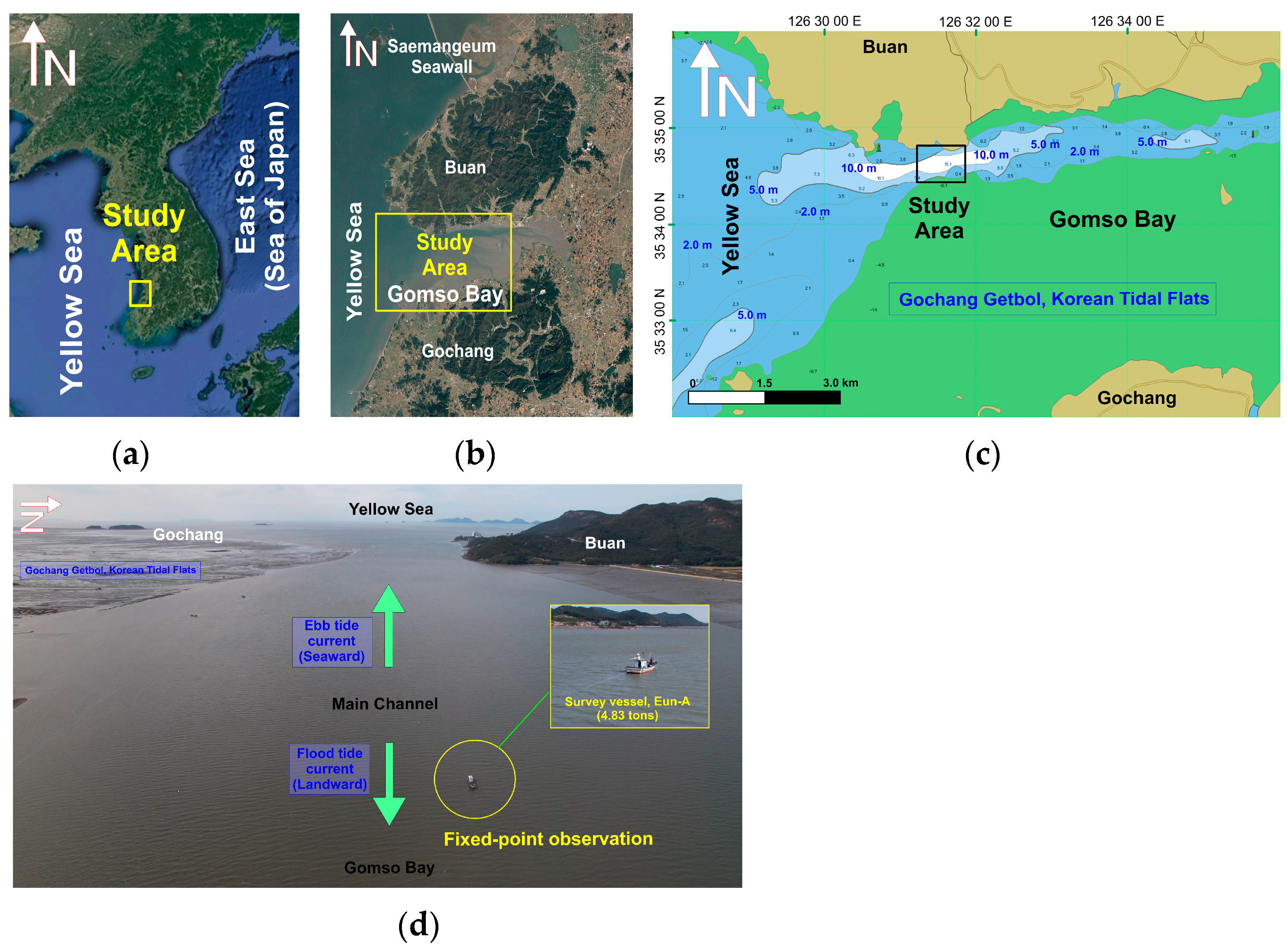


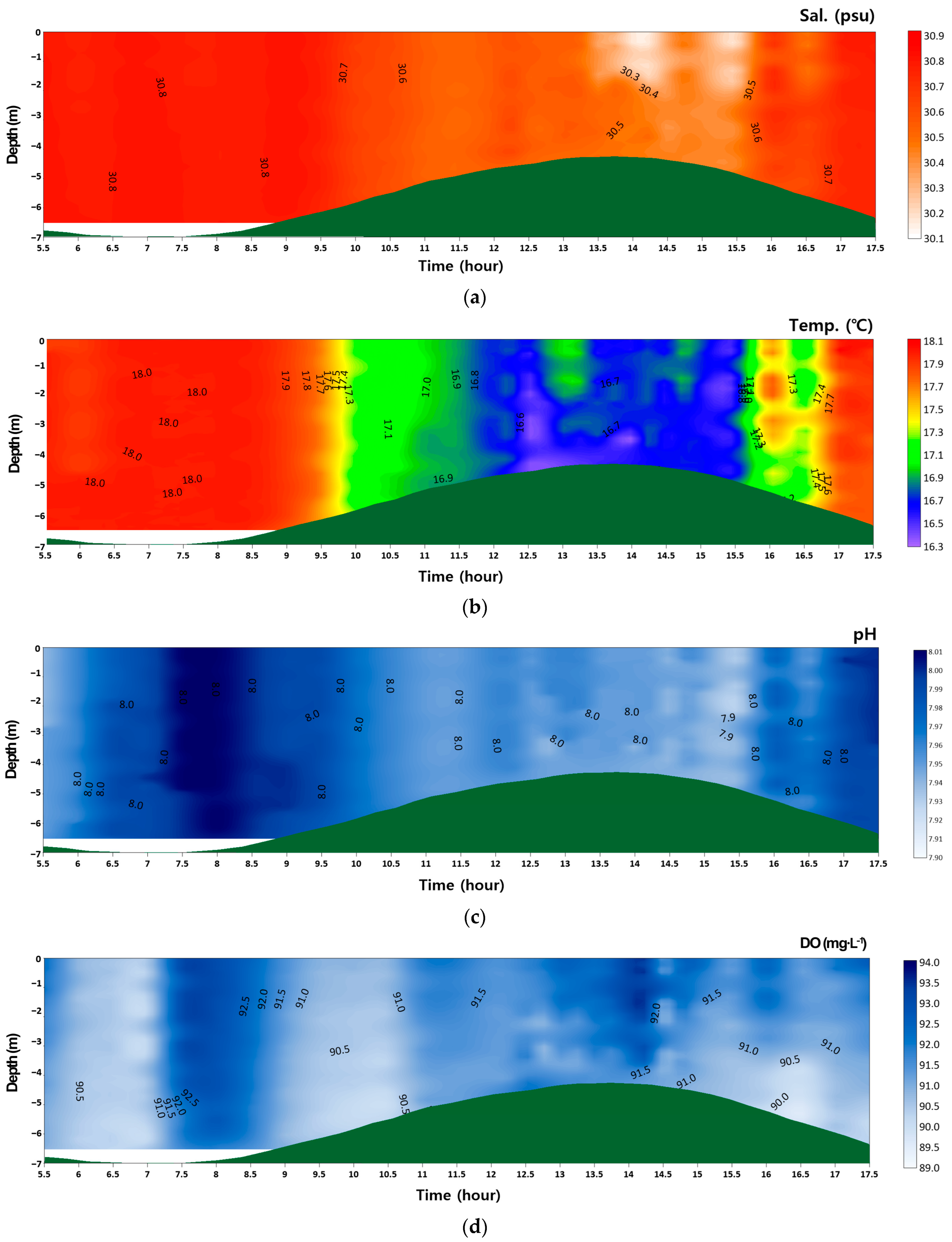
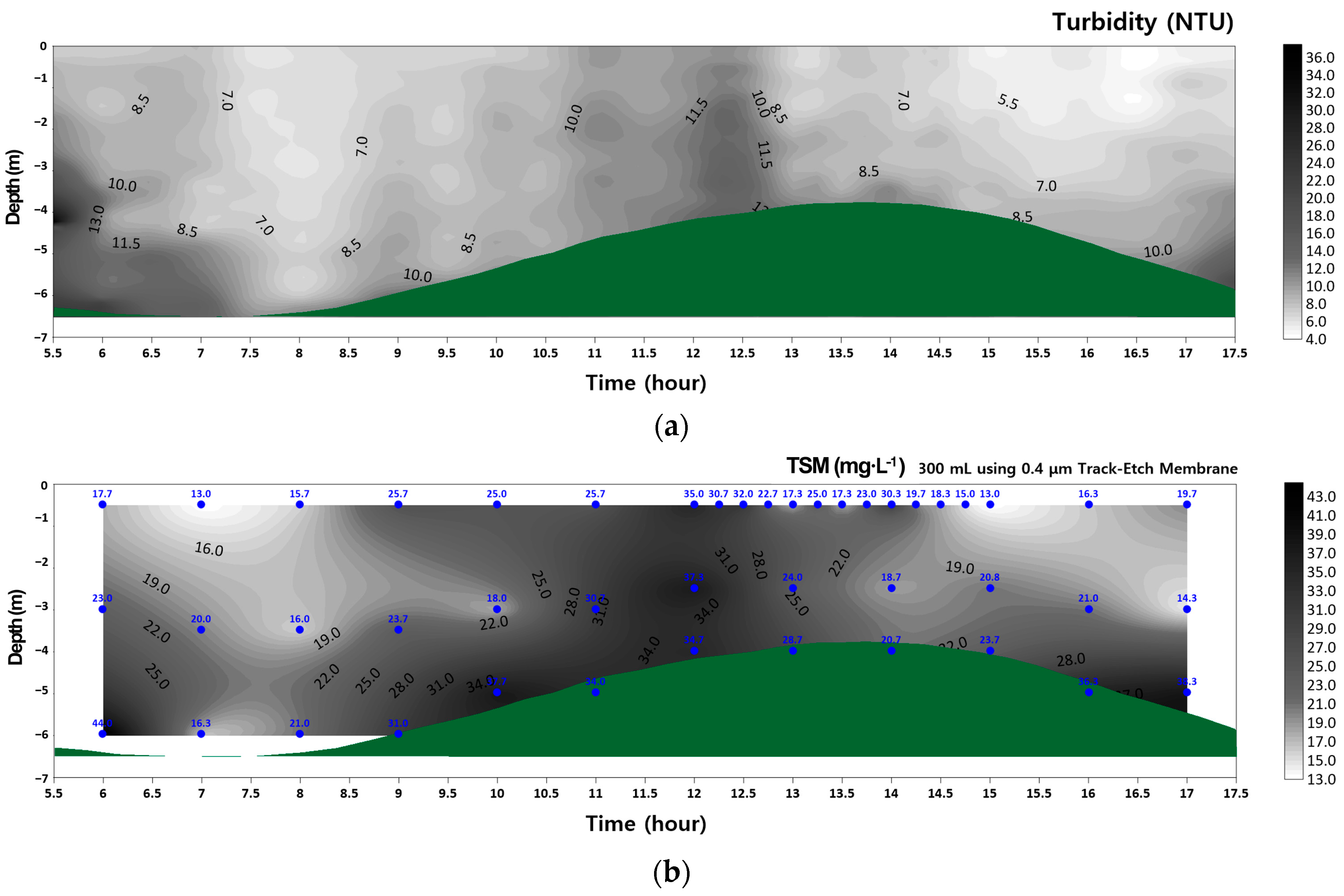
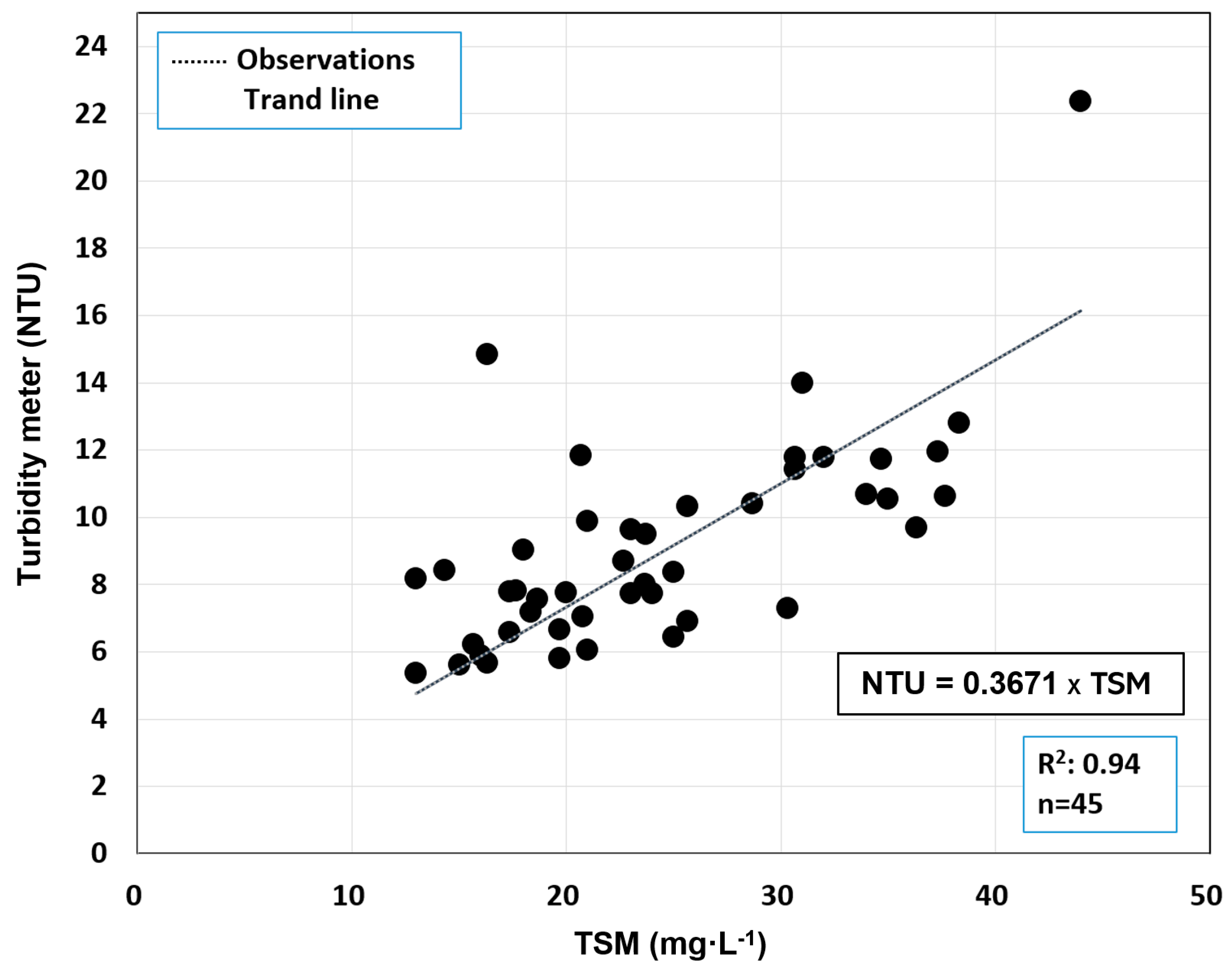
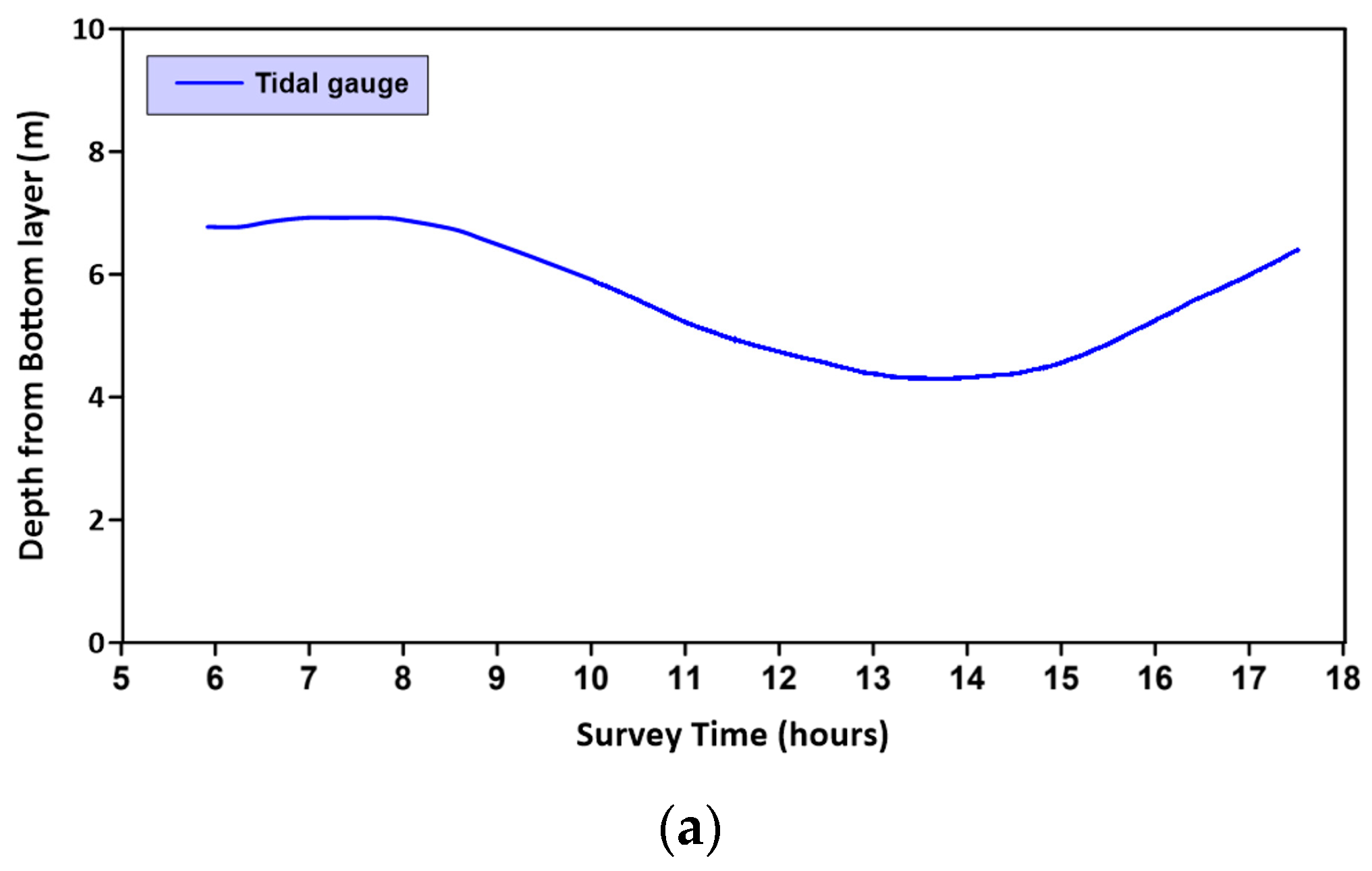
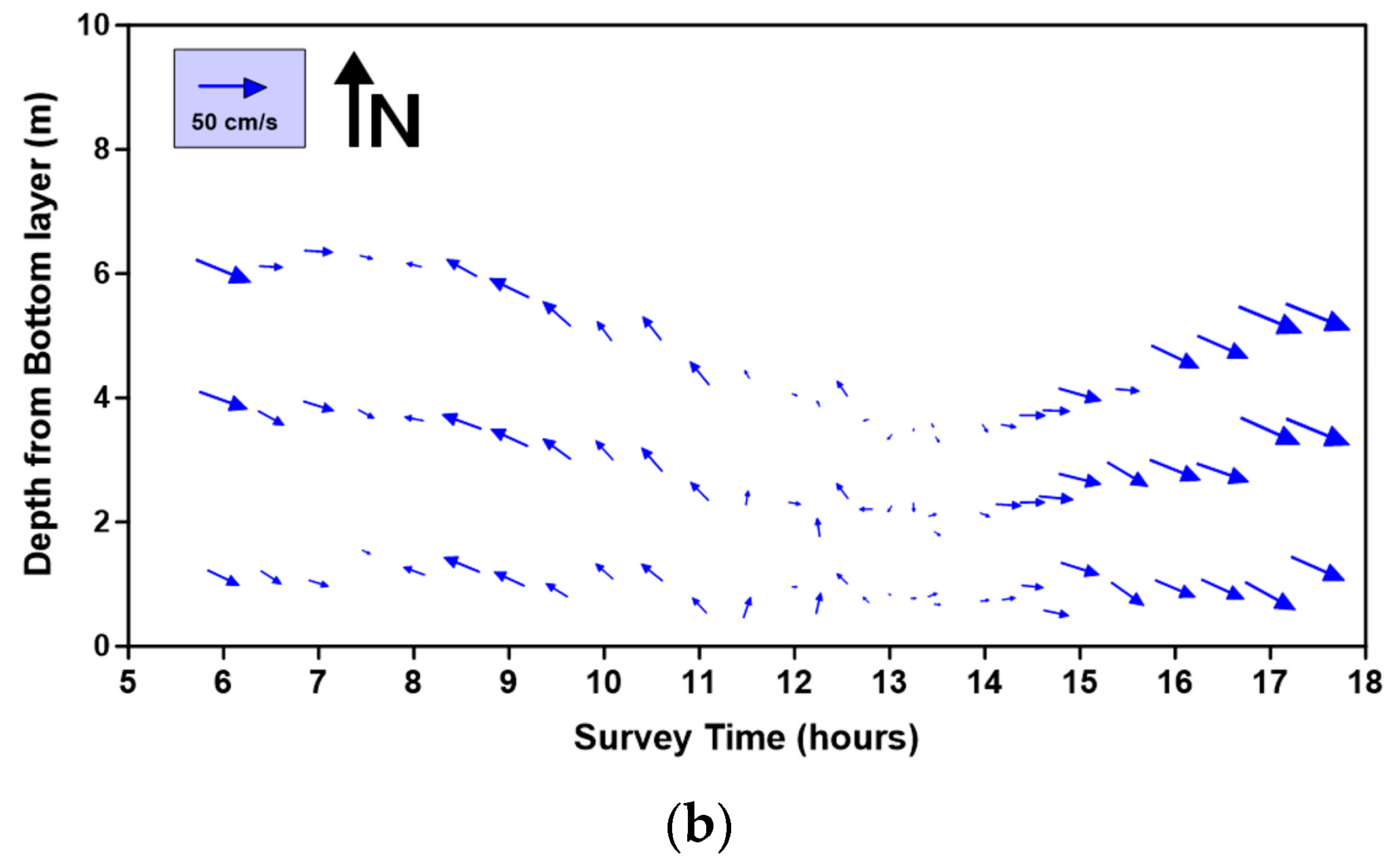
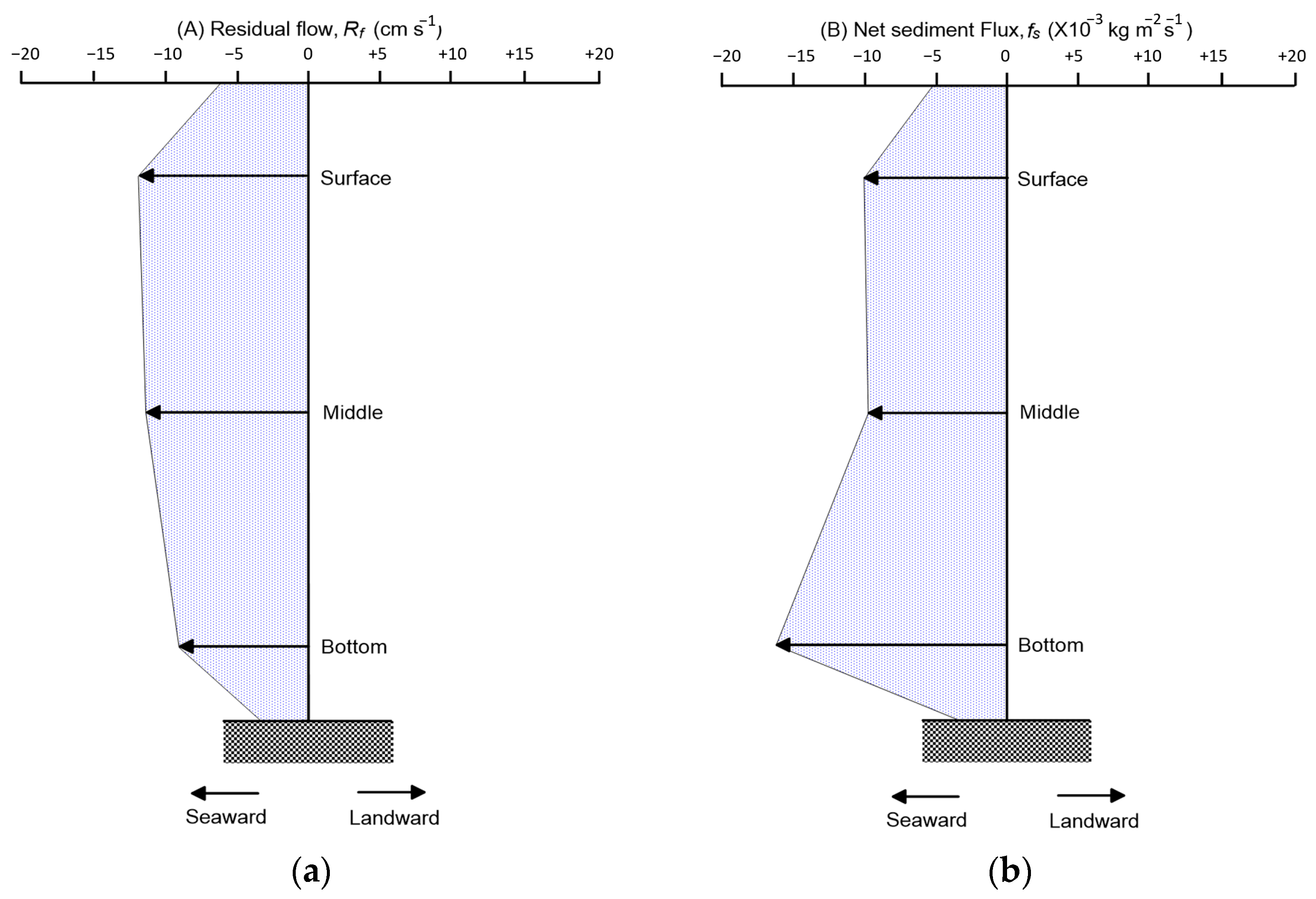

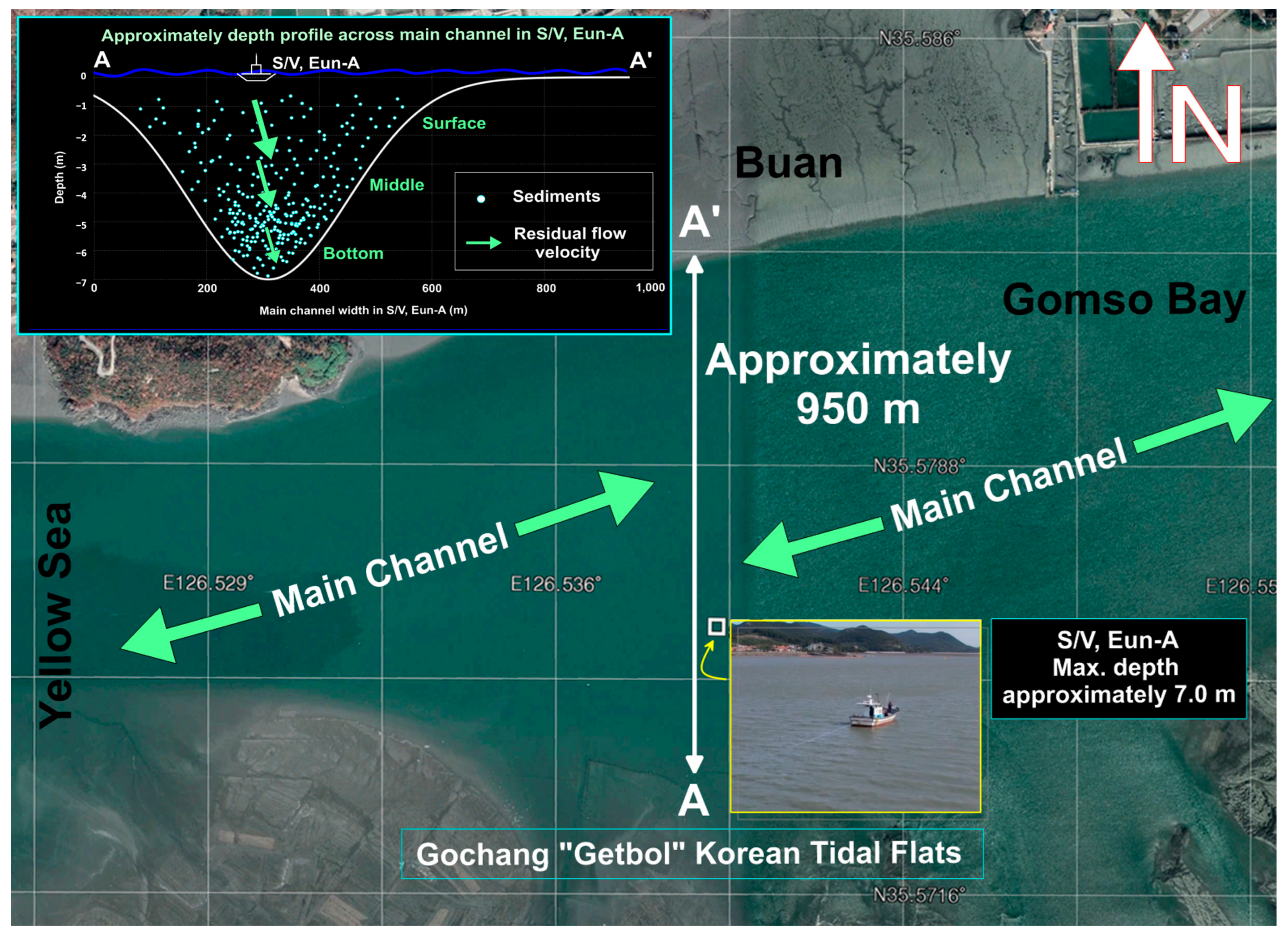
| Station | Layer | (cm·s−1) | (10−3 kg·m−2·s−1) | Net Sediment Transport Load (kg·m−1) Direction (Vector, °) | ||
|---|---|---|---|---|---|---|
| Gomso Bay (This study) | Surface | −13.15 | −10.33 | 5502.7 | 254.9 | 254.8 |
| Middle | −12.85 | −9.81 | 255.2 | |||
| Bottom | −8.90 | −16.49 | 254.2 | |||
| Study Region | Hydrodynamic Environments | Suspended Sediments Range (mg·L−1) | Calibration Relationships, R2 | Net Suspended Sediment Transport | Reference |
|---|---|---|---|---|---|
| Gomso Bay (1) (South Korea) | Semi-enclosed macrotidal bay with limited freshwater and a deep tidal channel | TSM ≈ 13–44 | NTU ≈ 0.367 × TSM, R2 = 0.94 (n = 45) | Qₛ ≈ 5503 kg·m−1 per tidal cycle (ebb-dominant), ~3.7–3.8 Mt·yr−1 (assuming a channel-scale (1) width of W = 950 m and an annual tidal frequency of N = 705 cycles) | This study |
| Taihu Lake, Estuary (China) | Wind–wave-dominated shallow lake–estuary system | TSM ≈ 0.2–398.9 | R2 = 0.63–0.68 (in the TSM–Optical reflectance relationship) | Not reported | [45] (Zhou et al., 2006) |
| Jiangsu Coast (China) | Macrotidal muddy environments | Not reported | FTU ≈ −2.89 × SSC2 + 80.4 × SSC + 3850.3, R2 = 0.99 (SSC ≥ 14.95 kg·m−3) | SSC ≈ 100~ (up to 1000–10,000) kg·m−1 | [46,47] (Wang et al., 2020; Wang et al., 2012) |
| Yangtze River (2) Estuary (China) | Highly turbid mesotidal estuary with multi-channel distributaries | SSC ≈ ~2500 (thesis expression, up to 2.5 kg·m−3) | NTU ≈ 416.4 × SSC, R2 = 0.99 (n = 32) | ~488 Mt·yr−1 (basin-scale (2)) | [48,49] (Jiang et al., 2024; Wang et al., 2008) |
| Dutch Tidal Bays (3) (Marsdiep inlet, Wadden Sea) | Mixed-energy tidal inlet connecting the North Sea & Wadden Sea | Not reported | Not reported | ~7–11 Mt·yr−1 (system-scale (3)) | [50,51] (Molen et al., 2022; Nauw et al., 2014) |
| Adour River Plume (France) | River-dominated coastal plume system | TSM ≈ 0.3–145.6 (about 1–100) | Turbidity in situ (NTU) ≈ 1.353 × TSM in situ –1.044, R2 = 0.996 (n = 65) | Not reported | [52] (Petus et al., 2010) |
| Hudson River Estuary (USA) | Partially mixed estuary with tidal reversals & hysteresis | TSS < 100 | TSS ≈ 1.2 × NTU, R2 = 0.52 (n = 219) | ~4.2–5.0 Mt·yr−1 (1990–2002 years, seaward); ~1.2 Mt·yr−1 (2004–2010 years, seaward) | [30,53] (Ralston et al., 2020; Erikson et al., 2013) |
Disclaimer/Publisher’s Note: The statements, opinions and data contained in all publications are solely those of the individual author(s) and contributor(s) and not of MDPI and/or the editor(s). MDPI and/or the editor(s) disclaim responsibility for any injury to people or property resulting from any ideas, methods, instructions or products referred to in the content. |
© 2025 by the authors. Licensee MDPI, Basel, Switzerland. This article is an open access article distributed under the terms and conditions of the Creative Commons Attribution (CC BY) license (https://creativecommons.org/licenses/by/4.0/).
Share and Cite
Lee, J.-H.; Jung, H.S.; Kim, K.; Jang, Y.; Lee, D.; Ryu, J.-H. Site-Specific Net Suspended Sediment Flux and Turbidity–TSM Coupling in a UNESCO Tidal Flat on the Western Coast of Korea: High-Resolution Vertical Observations. Water 2025, 17, 3361. https://doi.org/10.3390/w17233361
Lee J-H, Jung HS, Kim K, Jang Y, Lee D, Ryu J-H. Site-Specific Net Suspended Sediment Flux and Turbidity–TSM Coupling in a UNESCO Tidal Flat on the Western Coast of Korea: High-Resolution Vertical Observations. Water. 2025; 17(23):3361. https://doi.org/10.3390/w17233361
Chicago/Turabian StyleLee, Jun-Ho, Hoi Soo Jung, Keunyong Kim, Yeongjae Jang, Donguk Lee, and Joo-Hyung Ryu. 2025. "Site-Specific Net Suspended Sediment Flux and Turbidity–TSM Coupling in a UNESCO Tidal Flat on the Western Coast of Korea: High-Resolution Vertical Observations" Water 17, no. 23: 3361. https://doi.org/10.3390/w17233361
APA StyleLee, J.-H., Jung, H. S., Kim, K., Jang, Y., Lee, D., & Ryu, J.-H. (2025). Site-Specific Net Suspended Sediment Flux and Turbidity–TSM Coupling in a UNESCO Tidal Flat on the Western Coast of Korea: High-Resolution Vertical Observations. Water, 17(23), 3361. https://doi.org/10.3390/w17233361









